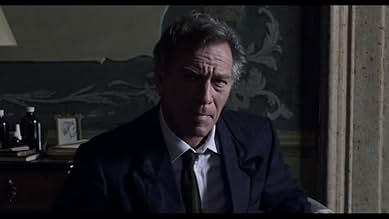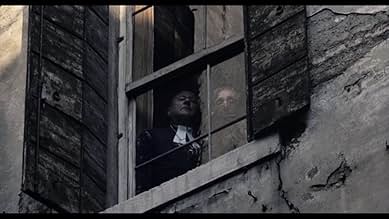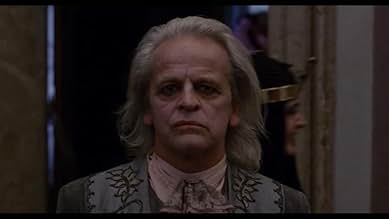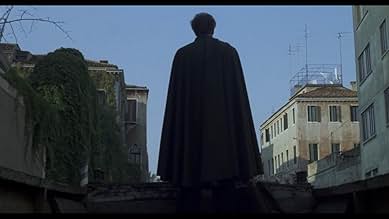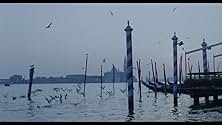CALIFICACIÓN DE IMDb
5.1/10
1.9 k
TU CALIFICACIÓN
El profesor Paris Catalano visita Venecia para investigar la última aparición conocida del famoso vampiro Nosferatu durante el carnaval de 1786.El profesor Paris Catalano visita Venecia para investigar la última aparición conocida del famoso vampiro Nosferatu durante el carnaval de 1786.El profesor Paris Catalano visita Venecia para investigar la última aparición conocida del famoso vampiro Nosferatu durante el carnaval de 1786.
- Dirección
- Guionistas
- Elenco
Maria Cumani Quasimodo
- Princess
- (as Maria Clementina Cumani Quasimodo)
La Chunga
- Woman at Gypsy Camp
- (as Micaela Flores Amaya 'La Chunga')
Mickey Knox
- Priest
- (sin créditos)
- Dirección
- Guionistas
- Todo el elenco y el equipo
- Producción, taquilla y más en IMDbPro
Opiniones destacadas
In VAMPIRE IN VENICE, Professor Paris Catalano (Christopher Plummer) is obsessed with tracking down the infamous blood-drinker of the title (Klaus Kinski). When Catalano finds a strange family in Venice, who were originally from Transylvania, he believes he's hit pay dirt.
This leads to the backstory being told, while Donald Pleasence makes an appearance.
When a medium is called in, resulting in a seance, the so-called "Prince of Putridity" returns! Death and doom are the result!
Kinski is quite convincing and threatening in his undead role. His interesting facial features have always made him the perfect villain, whether in horror or crime thrillers. He pulls off being pure eeevil with ease! Plummer is doggedly heroic as the Van Helsing-like Catalano.
While not a bad movie, it does tend to drag on interminably in spots...
This leads to the backstory being told, while Donald Pleasence makes an appearance.
When a medium is called in, resulting in a seance, the so-called "Prince of Putridity" returns! Death and doom are the result!
Kinski is quite convincing and threatening in his undead role. His interesting facial features have always made him the perfect villain, whether in horror or crime thrillers. He pulls off being pure eeevil with ease! Plummer is doggedly heroic as the Van Helsing-like Catalano.
While not a bad movie, it does tend to drag on interminably in spots...
This not-exactly-a-sequel to Herzog's remake, though with Kinski in the same role (albeit without the distinctive makeup-he apparently just refused to wear it again) is much better produced than the vast majority of 1980s Italian horror movies. The locations, costuming and photography are well above average, making the whole enterprise seem at least halfway to being a truly a quality effort. But despite that, and the fairly prestigious cast, the script runs a narrow gamut between the pedestrian and the messy, with some story continuity so weak you have to wonder if major scenes were left unfilmed, and the whole had to be patched together as well as possible in the editing room. (That wouldn't be surprising, as the producer went through several directors before deciding to take the job himself. Given the resulting production delays, his directorial inexperience, and the inevitable Kinski behavior problems, it seems likely the shoot was heavily compromised.)
Anyway, this movie is a bit of an attractive mess, jumbling together flashbacks, flamenco interludes, sexploitation, several deaths by fang, several others by fence-spike, a brief incongruous "Superman"-esque flying scene, and no coherent fix on the vampire's powers at all. (He seems to command wind, while having no particular problem with crosses or daylight.) Kinski walks though the movie looking aged-rockstar-cool (save when his fangs make him a little too Bugs Bunny-ish), Christopher Plummer (as a Van Helsing type) looks like he can't wait to fire the agent who got him here, but still feels professionally obligated to pretend to take his part seriously. Donald Pleasance simply seems superfluous; even when whipped into a ranting frenzy, he doesn't quite seem germane to the plot, such as it is.. Yorgo Voyagis, who may have been great in Greek cinema for all I know, is wooden once again in an international production. Barbara De Rossi looks very beautiful, which is all her part requires. (Well, that and a whole lot of nudity.)
Sometimes "Nosferatu in Venice" seems like it's aiming for some kind of melancholy pathos, sometimes just for rote thrills and kills (none very effectively done). Throughout the visual presentation has a certain poetical sumptuousness. (Kudos to the location scout-you can tell the film's largely 18th-century interiors are real places, not studio sets.) It doesn't make the leap to actual poetry, though, because the script is such a patch job. It's hard to tell just what the writer-director originally had in mind, because the film definitely has elements of an ambitious vision, but also major signs of having only realized that vision in part. So, not a good movie-but an interesting and watchable failure.
Anyway, this movie is a bit of an attractive mess, jumbling together flashbacks, flamenco interludes, sexploitation, several deaths by fang, several others by fence-spike, a brief incongruous "Superman"-esque flying scene, and no coherent fix on the vampire's powers at all. (He seems to command wind, while having no particular problem with crosses or daylight.) Kinski walks though the movie looking aged-rockstar-cool (save when his fangs make him a little too Bugs Bunny-ish), Christopher Plummer (as a Van Helsing type) looks like he can't wait to fire the agent who got him here, but still feels professionally obligated to pretend to take his part seriously. Donald Pleasance simply seems superfluous; even when whipped into a ranting frenzy, he doesn't quite seem germane to the plot, such as it is.. Yorgo Voyagis, who may have been great in Greek cinema for all I know, is wooden once again in an international production. Barbara De Rossi looks very beautiful, which is all her part requires. (Well, that and a whole lot of nudity.)
Sometimes "Nosferatu in Venice" seems like it's aiming for some kind of melancholy pathos, sometimes just for rote thrills and kills (none very effectively done). Throughout the visual presentation has a certain poetical sumptuousness. (Kudos to the location scout-you can tell the film's largely 18th-century interiors are real places, not studio sets.) It doesn't make the leap to actual poetry, though, because the script is such a patch job. It's hard to tell just what the writer-director originally had in mind, because the film definitely has elements of an ambitious vision, but also major signs of having only realized that vision in part. So, not a good movie-but an interesting and watchable failure.
Nosferatu in Venice (1988)
** (out of 4)
Klaus Kinski returns to the role of Nosferatu in this Italian film that was originally suppose to be a follow-up to Herzog's 1979 film. After various production issues including two director's being fired, the film ended up pretty much being 100% on its own with the only connection to the earlier film being Kinski. In the film, vampire hunter Paris Catalano (Christopher Plummer) travels to Venice, the last known location of the vampire Nosferatu (Kinski). Catalano tries to locate the whereabouts of the vampire who he believes has a desire to finally die. This is a rather interesting failure that has a lot going for it but it's obvious the production issues caused a lot of problems especially during the first part of the movie. The film starts off very ambitious as it centers on the Plummer character in current times but we then have several flashbacks to the earlier days of Nosferatu and how he became who he is. This was an interesting idea but it never really works for several reasons and one of them is a bizarre rock score that doesn't fit anything we see. Another reason these flashbacks never work is because at times it's hard to follow what exactly is going on and why certain flashbacks might be happening. Then, around the fifty-minute mark, something strange happens and the film actually turns extremely entertaining as Nosferatu finds himself in current times and falling in love with a young black lady who might just hold the key to his eventual death. Yes, Kinski drove several directors away from the film and this is partly to blame of the uneven film but you also have to give him credit because he turns in a great performance. He has his long blonde hair flowing and there's no chalk make-up so we get to see this Nosferatu in a very human-like state and the actor makes us feel sorry for this person who simply won't die. I found Kinski really intense throughout the film and this certainly spills over for several entertaining scenes but I think the romantic side works the best. Plummer is also pretty good in his rather thankless role and we even get Donald Pleasence in a role but he's pretty much wasted. Barbara De Rossi and Anne Knecht are both good as the ladies in the pack. Augusto Caminito, Mario Caiano, Luigi Cozzi and Maurizio Lucidi all did some work on the film but it was Caminito who ended up shooting the majority of the film. Even Kinski was apparently in charge of directing his scenes so who knows what was really going on with this production. It's certainly a very troubled movie but at the same time there's just so much here that does work in the end. We get some rather strong atmosphere and being 1988 and from Italy, there's much more sex, nudity and blood than normal, which is a plus. I doubt art house fans are going to enjoy this thing but if you're a horror fan and like Kinski then it would be worth your time to check this out. It's certainly not going to replace the Herzog film but it's an interesting little movie.
** (out of 4)
Klaus Kinski returns to the role of Nosferatu in this Italian film that was originally suppose to be a follow-up to Herzog's 1979 film. After various production issues including two director's being fired, the film ended up pretty much being 100% on its own with the only connection to the earlier film being Kinski. In the film, vampire hunter Paris Catalano (Christopher Plummer) travels to Venice, the last known location of the vampire Nosferatu (Kinski). Catalano tries to locate the whereabouts of the vampire who he believes has a desire to finally die. This is a rather interesting failure that has a lot going for it but it's obvious the production issues caused a lot of problems especially during the first part of the movie. The film starts off very ambitious as it centers on the Plummer character in current times but we then have several flashbacks to the earlier days of Nosferatu and how he became who he is. This was an interesting idea but it never really works for several reasons and one of them is a bizarre rock score that doesn't fit anything we see. Another reason these flashbacks never work is because at times it's hard to follow what exactly is going on and why certain flashbacks might be happening. Then, around the fifty-minute mark, something strange happens and the film actually turns extremely entertaining as Nosferatu finds himself in current times and falling in love with a young black lady who might just hold the key to his eventual death. Yes, Kinski drove several directors away from the film and this is partly to blame of the uneven film but you also have to give him credit because he turns in a great performance. He has his long blonde hair flowing and there's no chalk make-up so we get to see this Nosferatu in a very human-like state and the actor makes us feel sorry for this person who simply won't die. I found Kinski really intense throughout the film and this certainly spills over for several entertaining scenes but I think the romantic side works the best. Plummer is also pretty good in his rather thankless role and we even get Donald Pleasence in a role but he's pretty much wasted. Barbara De Rossi and Anne Knecht are both good as the ladies in the pack. Augusto Caminito, Mario Caiano, Luigi Cozzi and Maurizio Lucidi all did some work on the film but it was Caminito who ended up shooting the majority of the film. Even Kinski was apparently in charge of directing his scenes so who knows what was really going on with this production. It's certainly a very troubled movie but at the same time there's just so much here that does work in the end. We get some rather strong atmosphere and being 1988 and from Italy, there's much more sex, nudity and blood than normal, which is a plus. I doubt art house fans are going to enjoy this thing but if you're a horror fan and like Kinski then it would be worth your time to check this out. It's certainly not going to replace the Herzog film but it's an interesting little movie.
I'm a tremendously massive fan of the works and persona of Klaus Kinski, but apparently I should praise myself lucky that I never had to work with him or maybe even meet with him person. Kinski allegedly was an incredibly arrogant individual and literally an impossible person to interact with professionally. During this particular period – the late 80s – he also was at the heights of his violent temper, which (nearly) ruined all the movies he starred in. Director David Schmoeller made the ironic short film "Please Kill Mr. Kinski", based on the disastrous experience that he had with him during "Crawlspace" in 1986 and even the long-running professional relationship with the acclaimed director Werner Herzog got destroyed in 1987 during the filming of "Cobra Verde". According to the documentaries Herzog and Kinski got into several vicious fights and openly threatened to kill each other. Also this "Nosferatu in Venice" suffered enormously from Kinski's eccentric quirks. He chased away the initially hired director Mario Caiano, he physically assaulted two of the lead actresses and he refused to cut his hair or wear any make-up. And yet, it's a Kinski film and I'd move heaven and earth just to see it!
I liked "Nosferatu in Venice" a lot, but not exactly because it's a good film I'm much more fond of the whole idea and concept of the film. What a brilliant idea to set a vampire movie in the wonderful city of Venice! And not just any ravenous and mad-as-hell vampire, but a melancholic vampire figure like Nosferatu! That's just fantastic. The story initially follows Prof. Catalano, who's searching for the mysteriously vanished Nosferatu, but at the same time the professor is convinced that he is fed up with his immortal and roaming existence. Deep in the basement of a Venetian family mansion there is a tomb, and the heiress thinks that Nosferatu is buried here. They hold a séance to awaken him, but he resurrects somewhere on a tropical island. Nosferatu promptly travels to Venice, hoping to find love and eternal peace. "Noferatu in Venice" is slow-brooding and talkative, and thus definitely not recommended for the nowadays new generation of horror/vampire movie fanatics that swear by fancy computer-generated effects and monstrous transformations. This movie thrives on macabre atmosphere, moody set-pieces and sober cinematography. The plot is very messy and often doesn't make a lick of sense, and yet it's captivating from start to finish. This is also a very unconventional vampire story. Kinski's Nosferatu doesn't suck the blood from the virgin's necks, but he impales old ladies on fences and tears off the lips of jealous boyfriends. Kinski doesn't have to do a lot apart from demonstrating his naturally sinister charisma. The cast contains another two phenomenal actors, Donald Pleasance and Christopher Plummer, as well as a couple of beautiful actresses, like Barbara De Rossi.
I liked "Nosferatu in Venice" a lot, but not exactly because it's a good film I'm much more fond of the whole idea and concept of the film. What a brilliant idea to set a vampire movie in the wonderful city of Venice! And not just any ravenous and mad-as-hell vampire, but a melancholic vampire figure like Nosferatu! That's just fantastic. The story initially follows Prof. Catalano, who's searching for the mysteriously vanished Nosferatu, but at the same time the professor is convinced that he is fed up with his immortal and roaming existence. Deep in the basement of a Venetian family mansion there is a tomb, and the heiress thinks that Nosferatu is buried here. They hold a séance to awaken him, but he resurrects somewhere on a tropical island. Nosferatu promptly travels to Venice, hoping to find love and eternal peace. "Noferatu in Venice" is slow-brooding and talkative, and thus definitely not recommended for the nowadays new generation of horror/vampire movie fanatics that swear by fancy computer-generated effects and monstrous transformations. This movie thrives on macabre atmosphere, moody set-pieces and sober cinematography. The plot is very messy and often doesn't make a lick of sense, and yet it's captivating from start to finish. This is also a very unconventional vampire story. Kinski's Nosferatu doesn't suck the blood from the virgin's necks, but he impales old ladies on fences and tears off the lips of jealous boyfriends. Kinski doesn't have to do a lot apart from demonstrating his naturally sinister charisma. The cast contains another two phenomenal actors, Donald Pleasance and Christopher Plummer, as well as a couple of beautiful actresses, like Barbara De Rossi.
Don't really know if this movie can be regarded as an official sequel to the 1979 Werner Herzog movie "Nosferatu: Phantom der Nacht". Yes, it has Klaus Kinski again in it as the Nosferatu character but that is basically all that these two movies have in common. This movie got made by an entirely different production crew and even in an entirely different country.
5 directors later this is the end result. This movie was a real troubled production, that suffered from multiple delays during production, due to the falling out of directors and cast members, which resulted in the end that 5 different directors at certain points worked on the movie. The movie is a bit of a mess but at least its still an good looking mess.
Don't even really know what is the story in all of this. We have Nosferatu walking around in Venice and Christopher Plummer and Donald Pleasence but what they are doing in this movie, I still can't really tell. It has a pretty much non-existent story and it pretty much only relies on its dark eerie atmosphere and presence of once again Klaus Kinski as the immortal blood sucking vampire.
Kinski himself refused to wear the heavy make up he wore in "Nosferatu: Phantom der Nacht" and even didn't wanted to cut his hair for the role. So his look in this movie is very different from "Nosferatu: Phantom der Nacht". It's also definitely less scary looking all and it seems that they thought it would be enough to let the character stare a lot to make him work out as a scary or mysterious one. No, it just doesn't ever work, which makes his character a disappointing one and also makes it all seem quite pointless that Klaus Kinski after 9 years reprises his acclaimed role again. It was also one of the last movies he ever did, I wish I could say it also was an impressive and worthy one.
But it's just not a movie that you'll hate watching. I liked its style and atmosphere, that at times even became somewhat close to that of "Nosferatu: Phantom der Nacht". The movie is certainly a joy to watch for the eyes but then again which Venice based movie isn't?
Too bad that the movie just isn't ever really going anywhere. The movie makes some weird choices and the story just doesn't provide anything interesting enough. Not that you'll be bored with it but it's also far from a satisfying movie. It's a pretty pointless movie once you start thinking about it and is one you can really easily do without.
6/10
http://bobafett1138.blogspot.com/
5 directors later this is the end result. This movie was a real troubled production, that suffered from multiple delays during production, due to the falling out of directors and cast members, which resulted in the end that 5 different directors at certain points worked on the movie. The movie is a bit of a mess but at least its still an good looking mess.
Don't even really know what is the story in all of this. We have Nosferatu walking around in Venice and Christopher Plummer and Donald Pleasence but what they are doing in this movie, I still can't really tell. It has a pretty much non-existent story and it pretty much only relies on its dark eerie atmosphere and presence of once again Klaus Kinski as the immortal blood sucking vampire.
Kinski himself refused to wear the heavy make up he wore in "Nosferatu: Phantom der Nacht" and even didn't wanted to cut his hair for the role. So his look in this movie is very different from "Nosferatu: Phantom der Nacht". It's also definitely less scary looking all and it seems that they thought it would be enough to let the character stare a lot to make him work out as a scary or mysterious one. No, it just doesn't ever work, which makes his character a disappointing one and also makes it all seem quite pointless that Klaus Kinski after 9 years reprises his acclaimed role again. It was also one of the last movies he ever did, I wish I could say it also was an impressive and worthy one.
But it's just not a movie that you'll hate watching. I liked its style and atmosphere, that at times even became somewhat close to that of "Nosferatu: Phantom der Nacht". The movie is certainly a joy to watch for the eyes but then again which Venice based movie isn't?
Too bad that the movie just isn't ever really going anywhere. The movie makes some weird choices and the story just doesn't provide anything interesting enough. Not that you'll be bored with it but it's also far from a satisfying movie. It's a pretty pointless movie once you start thinking about it and is one you can really easily do without.
6/10
http://bobafett1138.blogspot.com/
¿Sabías que…?
- TriviaProducer Augusto Caminito originally hired director Maurizio Lucidi, who shot a few crowd scenes in Venice before the script had even been completed. Caminito decided that the project needed another director and fired Lucidi (paying him his full salary), hiring Pasquale Squitieri to write and direct the picture. However, Squitieri's screenplay proved too expensive to shoot so Caminito decided to stop working with him (he nevertheless paid him his full, hefty, salary). Shooting had already been postponed several times and the Italian TV network which co-produced the film was getting nervous. So Caminito hired a third director, B-movie veteran Mario Caiano, and shooting could start. On his first day, Klaus Kinski got into a violent argument with Caiano and refused to work with him. The director then agreed to leave the set (after being paid his full salary), the third director to leave the picture before principal photography was complete. Facing disaster, producer Augusto Caminito then decided to direct the film himself so he wouldn't have to pay another director. Since he had almost no directing experience, he was helped by his assistant Luigi Cozzi. Kinski also reportedly directed some scenes himself.
- ErroresWhile reading from the old text, Christopher Plummer pronounces the word "compare" as "com-pair," following English pronunciation. However, the Latin or Italian word "compare" should be pronounced "com-pa-reh," with each syllable distinctly enunciated and the final "e" softly pronounced. In Italian, "compare" means "godfather" or "companion," and the mispronunciation is particularly noticeable, given the historical and linguistic context of the text.
- ConexionesFeatured in FantastiCozzi (2016)
Selecciones populares
Inicia sesión para calificar y agrega a la lista de videos para obtener recomendaciones personalizadas
- How long is Vampire in Venice?Con tecnología de Alexa
Detalles
- Tiempo de ejecución1 hora 37 minutos
- Mezcla de sonido
- Relación de aspecto
- 1.85 : 1
Contribuir a esta página
Sugiere una edición o agrega el contenido que falta

